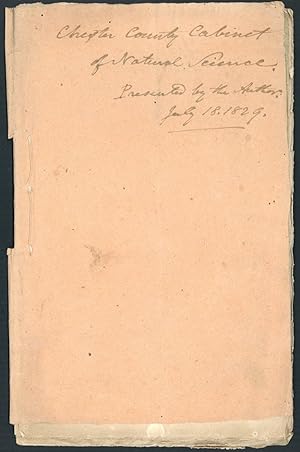Description Two New Species Fossil by Morton Samuel George (2 results)
FeedbackSearch filters
Product Type
- All Product Types
- Books (2)
- Magazines & Periodicals (No further results match this refinement)
- Comics (No further results match this refinement)
- Sheet Music (No further results match this refinement)
- Art, Prints & Posters (No further results match this refinement)
- Photographs (No further results match this refinement)
- Maps (No further results match this refinement)
- Manuscripts & Paper Collectibles (No further results match this refinement)
Condition
Binding
Collectible Attributes
- First Edition (1)
- Signed (1)
- Dust Jacket (No further results match this refinement)
- Seller-Supplied Images (2)
- Not Print on Demand (1)
Language (1)
Free Shipping
Seller Location
Seller Rating
-
Meeting for Business, May 26, 1846; Descriptions of Two New Species of Fossil Echinodermata, from the Eócene of the United States; Description of a New Species of Bat from Western Africa; Descriptions of New Species of Coleoptera of the United States (Continued); Description of a New Fresh-Water Shell, and Observations on Glandina obtusa, Pfeif. Volume 3 1846 [LeatherBound]
Publication Date: 2025
Seller: True World of Books, Delhi, India
£ 18.40
Convert currencyFree shipping from India to United KingdomQuantity: 18 available
Add to basketLeatherBound. Condition: New. Leather Binding on Spine and Corners with Golden leaf printing on spine. Bound in genuine leather with Satin ribbon page markers and Spine with raised gilt bands. A perfect gift for your loved ones. Reprinted from 1846 edition. NO changes have been made to the original text. This is NOT a retyped or an ocr'd reprint. Illustrations, Index, if any, are included in black and white. Each page is checked manually before printing. As this print on demand book is reprinted from a very old book, there could be some missing or flawed pages, but we always try to make the book as complete as possible. Fold-outs, if any, are not part of the book. If the original book was published in multiple volumes then this reprint is of only one volume, not the whole set and contains approximately 18 pages. IF YOU WISH TO ORDER PARTICULAR VOLUME OR ALL THE VOLUMES YOU CAN CONTACT US. Resized as per current standards. Sewing binding for longer life, where the book block is actually sewn (smythe sewn/section sewn) with thread before binding which results in a more durable type of binding. Language: English.
-
Description of two new species of fossil shells of the genera Scaphites and Crepidula
Publication Date: 1828
Seller: Jeremy Norman's historyofscience, Novato, CA, U.S.A.
First Edition Signed
£ 383.42
Convert currency£ 33.50 shipping from U.S.A. to United KingdomQuantity: 1 available
Add to basketMorton, Samuel George (1799-1851). Description of two new species of fossil shells of the genera Scaphites and Crepidula: With some observations on the ferruginous sand, plastic clay, and Upper Marine formations of the United States. Offprint from Journal of the Academy of Natural Sciences of Philadelphia 6 (1829). 16, 61-67pp. Engraved frontispiece by A. Lawson after Morton's drawings. 235 x 150 mm. (uncut). Original plain wrappers, creased vertically, a few minor tears. Margins a bit frayed, but very good. Presentation Copy, inscribed by Morton on the front wrapper: "Chester County Cabinet of Natural Science. Presented by the Author July 18, 1829." First Edition, Offprint Issue. Morton made significant contributions to paleontology at a time when natural history research in the United States was still in its infancy. An active member and officer of the Academy of Natural Sciences of Philadelphia, Morton took good advantage of his access to the Academy's extensive collections, studying fossil specimens delivered to Philadelphia from overseas ports or the American frontier. "Morton cemented his reputation as a paleontologist after describing fossils unearthed in the digging of the Chesapeake and Delaware Canal. Later, he was selected to describe the fossils that Lewis and Clark brought back with them from the American West. Morton's studies of fossils in Cretaceous sand and marl layers in New Jersey showed their relation to chalk regions of Europe. A century later, such research would be used to document continental drift." (Penn Museum). Morton had some skill as an artist: His paper on new fossil species of Scaphites (ammonites) and Crepidula (slipper shells) is illustrated with an engraving made from his drawings. "Morton's Life: Biography." Penn Museum. University of Pennsylvania Museum of Archaeology and Anthropology. Accessed 1/23/2019. .


![Seller image for Meeting for Business, May 26, 1846; Descriptions of Two New Species of Fossil Echinodermata, from the Eócene of the United States; Description of a New Species of Bat from Western Africa; Descriptions of New Species of Coleoptera of the United States (Continued); Description of a New Fresh-Water Shell, and Observations on Glandina obtusa, Pfeif. Volume 3 1846 [LeatherBound] for sale by True World of Books](https://pictures.abebooks.com/inventory/md/md31532956185.jpg)
